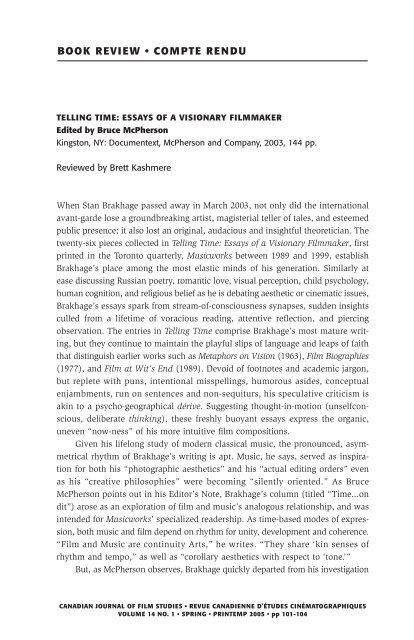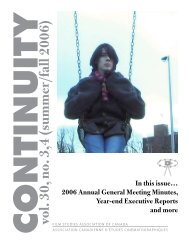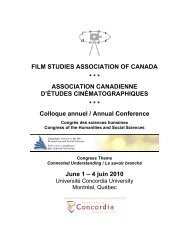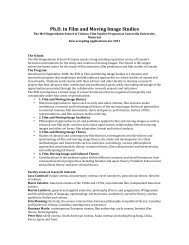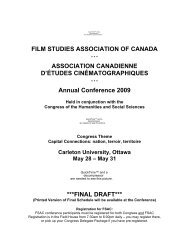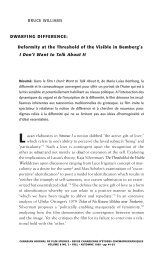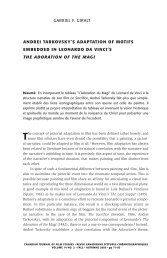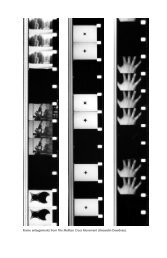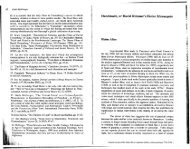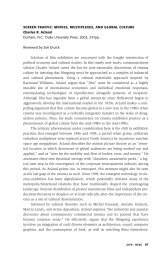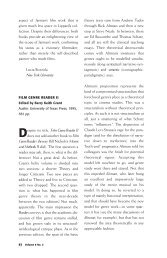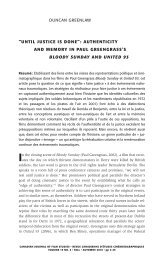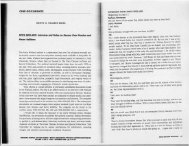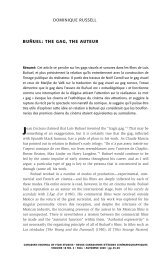PDF: Telling Time: Essays of a Visionary Filmmaker - Film Studies ...
PDF: Telling Time: Essays of a Visionary Filmmaker - Film Studies ...
PDF: Telling Time: Essays of a Visionary Filmmaker - Film Studies ...
Create successful ePaper yourself
Turn your PDF publications into a flip-book with our unique Google optimized e-Paper software.
BOOK REVI EW • COM PTE REN DU<br />
TELLING TIME: ESSAYS OF A VISIONARY FILMMAKER<br />
Edited by Bruce McPherson<br />
Kingston, NY: Documentext, McPherson and Company, 2003, 144 pp.<br />
Reviewed by Brett Kashmere<br />
When Stan Brakhage passed away in March 2003, not only did the international<br />
avant-garde lose a groundbreaking artist, magisterial teller <strong>of</strong> tales, and esteemed<br />
public presence; it also lost an original, audacious and insightful theoretician. The<br />
twenty-six pieces collected in <strong>Telling</strong> <strong>Time</strong>: <strong>Essays</strong> <strong>of</strong> a <strong>Visionary</strong> <strong><strong>Film</strong>maker</strong>, first<br />
printed in the Toronto quarterly, Musicworks between 1989 and 1999, establish<br />
Brakhage’s place among the most elastic minds <strong>of</strong> his generation. Similarly at<br />
ease discussing Russian poetry, romantic love, visual perception, child psychology,<br />
human cognition, and religious belief as he is debating aesthetic or cinematic issues,<br />
Brakhage’s essays spark from stream-<strong>of</strong>-consciousness synapses, sudden insights<br />
culled from a lifetime <strong>of</strong> voracious reading, attentive reflection, and piercing<br />
observation. The entries in <strong>Telling</strong> <strong>Time</strong> comprise Brakhage’s most mature writing,<br />
but they continue to maintain the playful slips <strong>of</strong> language and leaps <strong>of</strong> faith<br />
that distinguish earlier works such as Metaphors on Vision (1963), <strong>Film</strong> Biogra phies<br />
(1977), and <strong>Film</strong> at Wit’s End (1989). Devoid <strong>of</strong> footnotes and academic jargon,<br />
but replete with puns, intentional misspellings, humorous asides, conceptual<br />
enjambments, run on sentences and non-sequiturs, his speculative criticism is<br />
akin to a psycho-geographical dérive. Suggesting thought-in-motion (unselfconscious,<br />
deliberate thinking), these freshly buoyant essays express the organic,<br />
uneven “now-ness” <strong>of</strong> his more intuitive film compositions.<br />
Given his lifelong study <strong>of</strong> modern classical music, the pronounced, asymmetrical<br />
rhythm <strong>of</strong> Brakhage’s writing is apt. Music, he says, served as inspiration<br />
for both his “photographic aesthetics” and his “actual editing orders” even<br />
as his “creative philosophies” were becoming “silently oriented.” As Bruce<br />
McPherson points out in his Editor’s Note, Brakhage’s column (titled “<strong>Time</strong>...on<br />
dit”) arose as an exploration <strong>of</strong> film and music’s analogous relationship, and was<br />
intended for Musicworks’ specialized readership. As time-based modes <strong>of</strong> expression,<br />
both music and film depend on rhythm for unity, development and coherence.<br />
“<strong>Film</strong> and Music are continuity Arts,” he writes. “They share ‘kin senses <strong>of</strong><br />
rhythm and tempo,” as well as “corollary aesthetics with respect to ‘tone.’”<br />
But, as McPherson observes, Brakhage quickly departed from his investigation<br />
CANADIAN JOURNAL OF FILM STUDIES • REVUE CANADIENNE BOOK D’ÉTUDES REVIEW •CINÉMATOGRAPHIQUES COMPTE RENDU 101<br />
VOLUME 14 NO. 1 • SPRING • PRINTEMP 2005 • pp 101-104
<strong>of</strong> film and music parallels to explore a vast array <strong>of</strong> cultural, scientific and philosophical<br />
genres, drawing links between poetry, painting, astronomy, aesthetics,<br />
and phenomenology. An unwavering fascination with rhythm, however, permeates<br />
all <strong>of</strong> these interests. On the first page <strong>of</strong> the volume’s initial essay, “About<br />
<strong>Time</strong>,” Brakhage introduces Charles Olson’s famous dictum, “Of rhythm is<br />
image./ Of image is knowing/ And <strong>of</strong> knowing there is a construct.” These three<br />
lines form a wellspring for many subsequent departures, such as the book’s final,<br />
brief conjecture on vision, memory and perception. By juxtaposing open- and<br />
closed-eye descriptions <strong>of</strong> falling leaves, Brakhage illustrates how representational<br />
likeness is only one means for recounting a familiar visual scenario. He<br />
argues that we must forget how we are trained to see (i.e. the normative perspective<br />
derived from Renaissance art) in order to arrive at a fuller, more complex<br />
engagement with the natural world. In his example, the intertwined swirl <strong>of</strong> imagined,<br />
remembered, open-eye and hypnagogic images are inseparable components <strong>of</strong><br />
heightened perception. He writes, “The Leaf Ritual paradigm, which began this<br />
essay, can be read, then, as a verbal parable which attempts to explicate the<br />
results <strong>of</strong> such visual loss as is affiliated with the development <strong>of</strong> speech, as well as<br />
experienced as a lament composed <strong>of</strong> rhythms in memoriam.” Here, Brakhage’s<br />
oddly formed, prolix prose unintentionally points up the line dividing perception<br />
and description, while simultaneously confounding figurative associations.<br />
Contradictions between vision and language, between experience and arbitration,<br />
animate Brakhage’s central aesthetic concerns. His cinema attempts to<br />
create an unmediated vision through direct, ecstatic confrontation with the world.<br />
In this sense his filmmaking can be thought <strong>of</strong> as a performative art subject to<br />
coincidence and chance. But this notion takes for granted the discipline and precision<br />
<strong>of</strong> his shooting style (in part determined by financial necessity). Like Action<br />
Painting, projective verse, and jazz improvisation, Brakhage concentrates meaning<br />
in the individual spontaneous act, where the artist, free from logistical constraints<br />
and rational conscious thought, is both agent and site <strong>of</strong> interpretation.<br />
Brakhage’s writing is part <strong>of</strong> a larger attempt to transgress the limits <strong>of</strong> language,<br />
to arrive at a form that is purely cinematic and therefore outside <strong>of</strong> verbal<br />
description. As he claims in <strong>Telling</strong> <strong>Time</strong>, “Primarily I write to exhaust language<br />
on a given subject, to drive the mind beyond words, so that I can begin, and<br />
begin again and again where words-leave-<strong>of</strong>f [sic], veer their references into<br />
vision, each verbal connective synapse, to effect that my mind’s eye have full<br />
sway so that I can commence my work: I am a filmmaker.”<br />
To this reader, the most captivating sections <strong>of</strong> <strong>Telling</strong> <strong>Time</strong> recall or<br />
rehearse dialogues with his peers and/or investigate their work. Jim Davis, Phil<br />
Solomon and Bruce Elder are among the filmmakers who receive extended attention<br />
or close analysis. “An Inner Argument” relates a mid-1950s encounter at the New<br />
School for Social Research in New York City in which Brakhage misunderstood<br />
Davis’s claim that cinema had rendered all traditional arts superfluous. Thirty-five<br />
102 Volume 14 No. 1
years later, he <strong>of</strong>fers a posthumous corrective for his brash criticism, and an<br />
appreciation <strong>of</strong> Davis’s prescient vision. Brakhage upholds Davis’s realization <strong>of</strong><br />
film’s formal potential, while pondering the fundamental aesthetic tension in<br />
his work: a desire for pure, unnameable “light-play” on the one hand, and a (culturally<br />
imposed) deference to photographic “likeness” on the other. Brakhage’s<br />
writing on Solomon, a close friend, colleague and collaborator, is embedded<br />
within a two-part essay that unpacks several cultural myths around romantic love.<br />
Applying a psychoanalytic interpretation, Brakhage incisively extracts a subtle<br />
critique <strong>of</strong> the Romantic representation <strong>of</strong> children that runs throughout the layered<br />
visual fabric <strong>of</strong> Solomon’s lush, optically printed films. Finally, in his “argumentative<br />
dance” with Elder, to whom he claims “closer kinship than any other<br />
living filmmaker,” Brakhage’s postulate that thought can exist independently <strong>of</strong><br />
language, as felt sensation, is scrutinized.<br />
Elder’s films also receive consideration in the volume’s longest and most<br />
ambitious essay. “Space as Menace in Canadian Aesthetics,” which delineates<br />
common characteristics between the Group <strong>of</strong> Seven and Canadian avant-garde<br />
film, is a skilful act <strong>of</strong> comparative analysis, enabling the reader to perceive each<br />
tradition in a new (newly-shared) light. Enlisting the inspiriting treatment <strong>of</strong><br />
landscape as a primary point <strong>of</strong> reference, Brakhage outlines assorted tactics utilized<br />
by Canada’s first wave <strong>of</strong> cinema experimentalists, including Michael Snow,<br />
Jack Chambers, Keewatin Dewdney, Arthur Lipsett, David Rimmer, and Joyce<br />
Wieland; as well as a second wave comprised <strong>of</strong> Elder, Rick Hancox, Ellie Epp,<br />
Barbara Sternberg, Richard Kerr, Phil H<strong>of</strong>fman, Mike Hoolboom and others.<br />
Brakhage’s penetrating analysis <strong>of</strong> flattened perspective in Canadian film and<br />
painting validates him as a uniquely attentive and generous critic <strong>of</strong> Canadian<br />
art. Meanwhile, through his active touring and lecturing, as well as his long-running<br />
Monday night film salons, Brakhage engendered the first stateside recognition <strong>of</strong><br />
many <strong>of</strong> the aforementioned filmmakers. His encouragement and promotion <strong>of</strong><br />
daring lesser-known contemporaries remains one <strong>of</strong> his greatest legacies.<br />
Another noteworthy essay <strong>of</strong>fers a self-reflexive glimpse into Brakhage’s<br />
own artistic method. “Painting <strong>Film</strong>” imparts the synaptic mental processes that<br />
guide his hand-painted work. The image <strong>of</strong> a plate <strong>of</strong> salad atop his kitchen table,<br />
transposed into written words through the prism <strong>of</strong> his mind’s-eye, reveals (in<br />
both poetic and technical terms) how visual stimuli produced by the interplay <strong>of</strong><br />
light, shape, colour, and shifts <strong>of</strong> perspective are processed and translated onto<br />
strips <strong>of</strong> clear celluloid. And in “The Lost <strong>Film</strong>s” Brakhage endeavours to understand<br />
the elusive nature <strong>of</strong> his less-recognized films, such as Nightcats (1956),<br />
Oh Life-A Woe Story-The A Test News (1963), Black Vision (1965) and Nodes<br />
(1981). A body <strong>of</strong> 400 films is destined to yield overlooked and under-appreciated<br />
gems, not to mention ordinary or routine material. His sensitive consideration<br />
<strong>of</strong> these “visually ineffable,” “unremarkable,” “ghost films” demonstrate the<br />
evolving clarity an artist acquires about his or her own work over time.<br />
BOOK REVIEW • COMPTE RENDU 103
Throughout this volume Brakhage’s writing is eminently quotable, occasionally<br />
mystifying, and, at times, maddeningly allusive. Readers expecting an anthology<br />
<strong>of</strong> key articles, essays and statements, or a précis <strong>of</strong> Brakhage’s theoretical ideas<br />
and aesthetic interests, may be perplexed by the book’s wide-ranging subject matter<br />
as well as the idiosyncrasy and wandering arc <strong>of</strong> some <strong>of</strong> its texts. Many <strong>of</strong> the<br />
ideas presented in <strong>Telling</strong> <strong>Time</strong>, such as his notion <strong>of</strong> the “meat-ineffable,” a pictorial<br />
extreme <strong>of</strong> human consciousness in direct contrast to “geometric” thought,<br />
challenge accepted modes <strong>of</strong> behaviour, communication and perception.<br />
<strong>Telling</strong> <strong>Time</strong> is an elegant, thoroughly engaging, timely and wide-ranging<br />
work—though the cover image, which features hand-painted frames from<br />
Brakhage’s Dante Quartet (1987), might suggest at first glance a book simply about<br />
his filmmaking. As evidenced by the Chicago Review’s special issue, Stan<br />
Brakhage: Correspondences (Winter 2001/Spring 2002), the DVD entitled By<br />
Brakhage, a two-disc set released by Criterion in 2003, and Brakhage, Jim<br />
Shedden’s 2001 feature documentary, <strong>Telling</strong> <strong>Time</strong> arrives at a period <strong>of</strong> increased<br />
interest in, and dissemination <strong>of</strong>, the work <strong>of</strong> this legendary avant-garde filmmaker.<br />
This situation is destined to expand over the coming years: a collection <strong>of</strong><br />
essays, photographs, personal statements, and reminiscences about Brakhage,<br />
edited by David James, is already forthcoming, while other DVD plans are currently<br />
in the works. These recent and impending additions to the Brakhage literature<br />
and home video catalogue continue to entrench his legacy as the twentieth<br />
century’s most significant American film artist. <strong>Telling</strong> <strong>Time</strong> is an essential book<br />
for anyone interested in Brakhage, theories <strong>of</strong> visual perception, the relationship<br />
<strong>of</strong> film to music, and the beats in between.<br />
Concordia University<br />
104 Volume 14 No. 1


